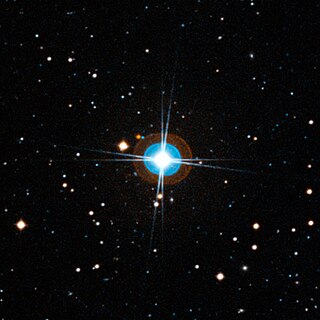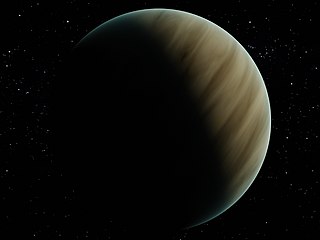
54 Piscium is an orange dwarf star approximately 36 light-years away in the constellation of Pisces. In 2003, an extrasolar planet was confirmed to be orbiting the star, and in 2006, a brown dwarf was also discovered orbiting it.
79 Ceti, also known as HD 16141, is a binary star system located 123 light-years from the Sun in the southern constellation of Cetus. It has an apparent visual magnitude of +6.83, which puts it below the normal limit for visibility with the average naked eye. The star is drifting closer to the Earth with a heliocentric radial velocity of −51 km/s.

HD 164922 is a seventh magnitude G-type main sequence star in the constellation of Hercules. To view it, binoculars or a telescope are necessary, as it is too faint to be visible to the naked eye. It is 71.7 light-years distant from the Earth. It will soon evolve away from the main-sequence and expand to become a red giant.
HD 11964 is a binary star system located 110 light-years away from the Sun in the equatorial constellation of Cetus. It is visible in binoculars or a telescope but is too faint to be seen with the naked eye, having an apparent visual magnitude of 7.51. The system is drifting closer to the Sun with a radial velocity of −9 km/s. Two extrasolar planets have been confirmed to orbit the primary.
HD 210702 is an orange subgiant star located approximately 177 light-years away in the constellation of Pegasus. With a mass of 1.8 times that of the Sun, the star spent its main-sequence life as an A-type star. The visual luminosity is 11.38 times that of the Sun and the magnitude is near the naked-eye limit, but binoculars can easily see it.
HD 118203 is a star located in the northern circumpolar constellation of Ursa Major. It has the proper name Liesma, which means flame, and it is the name of a character from the Latvian poem Staburags un Liesma. The name was selected in the NameExoWorlds campaign by Latvia, during the 100th anniversary of the IAU.
HD 192699 b, also named Khomsa, is an exoplanet located approximately 214 light-years away in the constellation of Aquila, orbiting the star HD 192699. This planet was discovered in April 2007, massing at least 2.5 times the mass of Jupiter (MJ). Despite its orbital distance more than that of Earth, the orbital period is less than a year, because the parent star is more massive than the Sun.
HD 212771 b is an extrasolar planet orbiting the G-type star HD 212771 approximately 364 light years away in the constellation Aquarius.

HD 10180, also designated 2MASS J01375356-6030414, is a Sun-like star in the southern constellation Hydrus that is notable for its large planetary system. Since its discovery, at least six exoplanets have been observed orbiting it, and some studies have proposed up to nine potential planets, which would make it potentially the largest of all known planetary systems, including the Solar System.
HD 181342 is a star in the constellation of Sagittarius. With an apparent magnitude of 7.55, it cannot be seen with the naked eye. Parallax measurements made by Gaia spacecraft put the star at a distance of 394 light-years away.

HD 179070, also known as Kepler-21, is a F-type subgiant star 354 light-years away in the constellation Lyra. A transiting exoplanet was discovered orbiting this star by the Kepler spacecraft. At a magnitude of 8.25 this was the brightest star observed by Kepler to host a validated planet until the discovery of an exoplanet orbiting HD 212657 in 2018.

HD 21749 is an orange main-sequence star in the constellation Reticulum. It has an apparent visual magnitude of 8.143, which means it is too dim to be seen with the naked eye. From parallax measurements by the Gaia spacecraft, it is located 53 ly (16 pc) from Earth.

HD 102956 b or Isagel is an extrasolar planet discovered in 2010 by a team of American astronomers led by John Johnson using Doppler spectroscopy and the Keck Observatory in Hawaii. HD 102956 b is in the orbit of host star HD 102956. The planet is at most the mass of Jupiter, orbiting every 6.5 days at a distance of 12 million km. HD 202956 b has a very circular orbit. The system is roughly 399 light years from us.
GJ 3470 is a red dwarf star located in the constellation of Cancer, 96 light-years away from Earth. With a faint apparent magnitude of 12.3, it is not visible to the naked eye. It hosts one known exoplanet.
HD 260655 is a relatively bright and cool M0 V red dwarf star located 33 light-years away from the Solar System in the constellation of Gemini. HD 260655 has two confirmed rocky planets, named HD 260655 b and HD 260655 c, that were discovered in 2022. Both planets were detected by the TESS mission and confirmed independently with archival and new precise radial velocity data obtained with the HIRES observatory since 1998, and the CARMENES survey instruments since 2016.
HD 152843 is an early G-type main sequence bright star located 356 light-years away from Earth in the constellation of Hercules. The star is similar to the Sun, with a mass of 1.15 solar masses and a radius of 1.43 solar radii. HD 152843 has been discovered to have two exoplanets orbiting it.
HD 221416 b is a confirmed hot Saturn type exoplanet located 312 light years away from earth and orbiting the late subgiant K-type star, HD 221416. It is part of a small but growing number of discovered exoplanets orbiting evolved stars. This planet was discovered in 2019 by using the primary transit method.
TOI-813 is a bright subgiant G-type star located 858 light-years away from planet Earth. It is too faint to be seen with the naked eye. TOI-813 has a mass of 1.32 solar masses, a radius of 1.95 solar radii and a luminosity of 4.3 times the solar luminosity.

TOI-813 b is a Saturn sized exoplanet orbiting the star TOI-813, a evolved and bright subgiant G-type star located 858 light years away from Earth. The exoplanet is a Neptune like gas giant type planet with 42 earth masses and 6.7 earth radii. In approximately 780 million years, the planet will be engulfed and destroyed by its parent star.
Kepler-385 is an F-type main-sequence star located about 4,900 light-years away from Earth in the constellation of Cygnus. The star is 10% larger and 5% hotter than the Sun. The star has at least three, and potentially up to seven, exoplanets discovered orbiting it.







